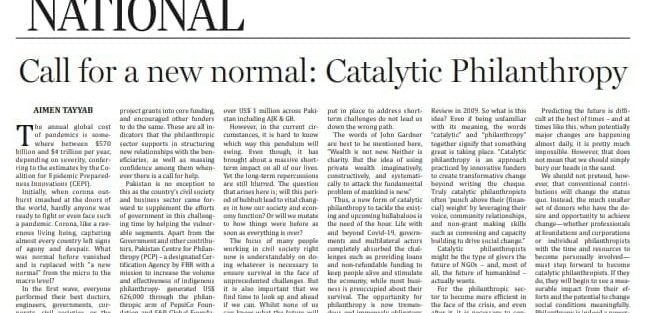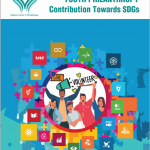The annual global cost of pandemics is somewhere between $570 billion and $4 trillion per year, depending on severity, conferring to the estimates by the Coalition for Epidemic Preparedness Innovations (CEPI).
Initially, when corona outburst smashed at the doors of the world, hardly anyone was ready to fight or even face such a pandemic. Corona, like a ravenous living being, capturing almost every country left signs of agony and despair. What was normal before vanished and is replaced with “a new normal” from the micro to the macro level?
In the first wave, everyone performed their best doctors, engineers, governments, corporate, civil societies, or the general public to contribute in one way or another in the time of upheaval. All came up with a spot-on response to the crisis. Many funders adapted their frames and loosened their grant agreements, launching special emergency funds, transforming project grants into core funding, and encouraged other funders to do the same. These are all indicators that the philanthropic sector supports in structuring new relationships with the beneficiaries, as well as massing confidence among them whenever there is a call for help.
Pakistan is no exception to this as the country’s civil society and business sector came forward to supplement the efforts of government in this challenging time by helping the vulnerable segments. Apart from the Government and other contributors, Pakistan Centre for Philanthropy (PCP) – a designated Certification Agency by FBR with a mission to increase the volume and effectiveness of indigenous philanthropy- generated US$ 626,000 through the philanthropic arm of PepsiCo Foundation and S&P Global Foundation to provide ration packages comprising food supplies in 30 districts across four provinces. Whereas PCP and Give2Asia being strategic partners of nationwide disaster relief program, connected a few PCP Certified NPOs, and distributed meals of over US$ 1 million across Pakistan including AJK & GB.
However, in the current circumstances, it is hard to know which way this pendulum will swing. Even though, it has brought about a massive short-term impact on all of our lives. Yet the long-term repercussions are still blurred. The question that arises here is; will this period of hubbub lead to vital changes in how our society and economy function? Or will we mutate to how things were before as soon as everything is over?
The focus of many people working in civil society right now is understandably on doing whatever is necessary to ensure survival in the face of unprecedented challenges. But it is also important that we find time to look up and ahead if we can. Whilst none of us can know what the future will bring, but we can start to identify key questions and possible scenarios. That way we can work backward to what needs to be done now, to ensure we maximize the chances of ending up with the future we want, or conversely that measures put in place to address short-term challenges do not lead us down the wrong path.
The words of John Gardner are best to be mentioned here, “Wealth is not new. Neither is charity. But the idea of using private wealth imaginatively, constructively, and systematically to attack the fundamental problem of mankind is new.”
Thus, a new form of catalytic philanthropy to tackle the existing and upcoming hullabaloos is the need of the hour. Life with and beyond Covid-19, governments and multilateral actors completely absorbed the challenges such as providing loans and non-refundable funding to keep people alive and stimulate the economy, while most business is preoccupied about their survival. The opportunity for philanthropy is now tremendous and immensely obligatory. Catalytic social investments by philanthropists, today, have an unmatched chance to play a crucial role in building on under-appreciated models.
Mark Kramer first used the term “Catalytic Philanthropy” in Stanford Social Innovation Review in 2009. So what is this idea? Even if being unfamiliar with its meaning, the words “catalytic” and “philanthropy” together signify that something great is taking place. “Catalytic philanthropy is an approach practiced by innovative funders to create transformative change beyond writing the cheque. Truly catalytic philanthropists often ‘punch above their (financial) weight’ by leveraging their voice, community relationships, and non-grant making skills such as convening and capacity building to drive social change.”
Catalytic philanthropists might be the type of givers the future of NGOs – and, most of all, the future of humankind – actually wants.
For the philanthropic sector to become more efficient in the face of the crisis, and even after it, it is necessary to consider adopting the proposal described above. Appearing as an essential driving force in such a major crisis can help the sector make the case for a more favorable environment and supportive policies for civil society and philanthropy in the long term.
Predicting the future is difficult at the best of times – and at times like this, when potentially major changes are happening almost daily, it is pretty much impossible. However, that does not mean that we should simply bury our heads in the sand.
We should not pretend, however, that conventional contributions will change the status quo. Instead, the much smaller set of donors who have the desire and opportunity to achieve change—whether professionals at foundations and corporations or individual philanthropists with the time and resources to become personally involved—must step forward to become catalytic philanthropists. If they do, they will begin to see a measurable impact from their efforts and the potential to change social conditions meaningfully. Philanthropy is indeed a powerful tool for social progress, but only when donors make it so.
Indubitably:”For a global pandemic, we need to have global solutions.”



